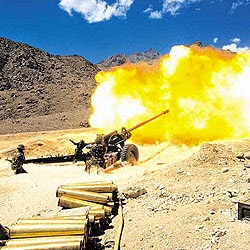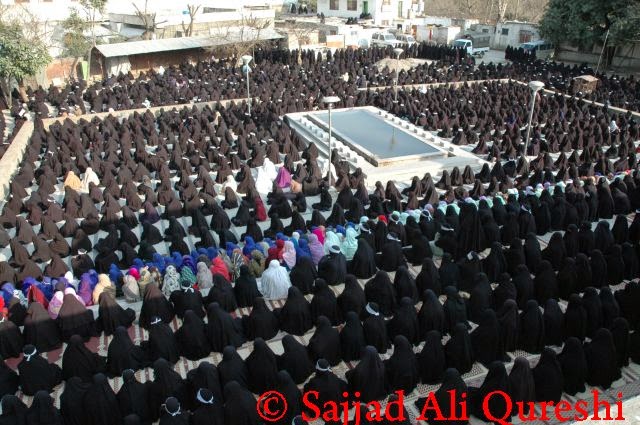Basharat Peer makes many excellent points about the experience of muslims under Modi-raj- literally slow poisoning them with pollution- but he also does not suggest a way forward for South Asian communities to co-exist peacfully. A world renowned (Kashmiri) man of letters is unable to spare a few words about his fellow Kashmiri Pandits who have been permanently expelled from the valley. They too have their own Citizen Nagars where poisons are choking off the lives of small children. Peer is (justifiably) focused on the slums of Juhapura but prefers to avoid references to the ones closer to home in Jammu. Why not denounce the 2-nation theory as well- your villains are our heroes and vice versa– ideological poisons once injected into the system will not automatically drain away (due to vested interests on both sides).
Someone wise said on these pages that today in India you can get killed for being a muslim, while in Pakistan you can get killed for being a different type of muslim. Then again, when it comes to discussing the state of Hindus in Pakistan and in Bangladesh (and in Sri Lanka) most people prefer to avert their gaze (Hindus foremost amongst them).
If we want to be inclusive and desire peaceful co-existence (and there is really no other rational path) we should call out all the bandits regardless of their badge. And call for secularism in the public square. And.. the list is endless.
The
problem isn’t just about rhetoric. Judging by the evidence in Gujarat,
where Mr. Modi has been chief minister since 2001, a B.J.P. victory in
the general election would increase marginalization and vulnerability
among India’s 165 million Muslims.
Gujarat’s largest city, has become a wealthy metropolis of about six
million people and three million private vehicles. Office complexes,
high-rise apartments, busy markets and shopping malls have replaced the
poor villages that once dotted the land. The city has a mass transit
system called People’s Path, with corridors reserved for buses.
Ahmedabad ceases to swagger in Juhapura, a southwestern neighborhood
and the city’s largest Muslim ghetto, with about 400,000 people. I rode
around there last week on the back of a friend’s scooter. On the dusty
main street was a smattering of white and beige apartment blocks and
shopping centers. A multistory building announced itself in neon signs
as a community hall; a restaurant boasted of having air-conditioning.
The deeper we went into the neighborhood, the narrower the streets, the
shabbier the buildings, the thicker the crowds.
edge of the ghetto came abruptly. Just behind us was a row of tiny,
single-story houses with peeling paint. Up ahead, in an empty space the
size of a soccer field, children chased one another, jumping over heaps
of broken bricks. “This is The Border,” my friend said. Beyond the field
was a massive concrete wall topped with barbed wire and oval
surveillance cameras. On the other side, we could see a neat row of
beige apartment blocks with air conditioners securely attached to the
windows — housing for middle-class Hindu families.
Modi’s engines of growth seem to have stalled on The Border. His
acclaimed bus network ends a few miles before Juhapura. The route of a
planned metro rail line also stops short of the neighborhood. The same
goes for the city’s gas pipelines, which are operated by a company
belonging to a billionaire businessman close to Mr. Modi.
Pathan has been living in Juhapura since 1988, when his father, a
retired district judge, bought a house here from a Hindu man. “My father
said, ‘When the storm comes, you don’t get more than 10 minutes to
run,”’ Mr. Pathan explained, referring to the threat of sectarian
violence. In the late 1970s and early 1980s, Juhapura was a mixed
Hindu-Muslim neighborhood, but with the string of sectarian clashes in
Gujarat — in 1985, 1992 and 2002 — more Muslims began to move here,
seeking relative safety among people like themselves. Prejudice begets
riots, and riots only exacerbate prejudice, and so the population of
Juhapura has almost doubled since 2002.
the 2002 riots, Mr. Pathan, a teacher, began tutoring children in
Juhapura. Then he quit his job and, with his father’s support, bought a
large patch of land by the highway that runs through Juhapura. In 2008
he started his own school. Now, around 1,300 children there attend
classes in both Gujarati and English in airy classrooms. “We simply have
to help ourselves,” Mr. Pathan said.
self-help only goes so far, in Juhapura, and elsewhere. A large chunk
of Narol, an area on the southern edge of Ahmedabad, was once a patch of
uninhabited brushland that belonged to a wealthy political family.
After Mr. Modi’s government refused to help relocate victims of the 2002
riots, several secular and Islamic organizations and small-time Muslims
developers got involved. They bought land, cleared it, and built
tenement houses, asbestos-lined roofs and all. About 120 homes were
assigned by lottery to Muslims displaced from Naroda Patia, in northeast
Ahmedabad.
and wherever you stand in the self-made neighborhood you can see, half a
mile away, a big brown mountain: the largest garbage dump in Mr. Modi’s
boom city.
I walked around Citizens’ Nagar last week, the brown mountain was
burning into thick gray clouds under a harsh afternoon sun. The wind
pushed pungent fumes toward the tenements. I struggled to breathe and
feared I would vomit.
year we have lived here I feel weaker,” said Mohsin Syed, a wiry
25-year-old from Naroda Patia who now works as a carpenter in a factory
nearby. “I can’t run like I used to. I don’t eat like I used to.” He
complained of pain in his joints, said he needed surgery for kidney
stones, and added, “This place, this pollution, takes a decade off one’s
life.”
…….
Link: http://www.nytimes.com/2014/04/19/opinion/being-muslim-under-narendra-modi.html
……
regards


